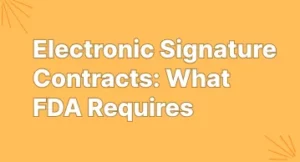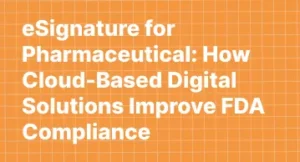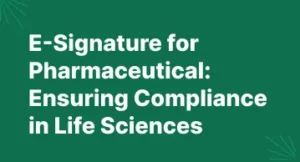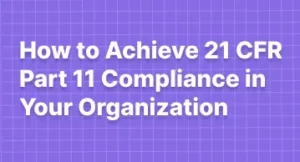Pharma: Multi-Factor Authentication for 21 CFR Part 11 Compliance
Introduction
Pharma companies operate in a highly regulated environment where data security and compliance are paramount. Ensuring compliance with 21 CFR Part 11 is critical for maintaining data integrity, particularly in electronic records and signatures. One of the most effective ways to enhance security and meet compliance requirements is through Multi-Factor Authentication (MFA) .
With rising cyber threats and stringent regulatory demands, relying on passwords alone is no longer sufficient. MFA adds an extra layer of protection, ensuring that only authorized personnel can access sensitive records and systems.
Let’s explore how MFA strengthens regulatory compliance and operational security in the pharmaceutical industry.
What is Multi-Factor Authentication (MFA)?
MFA is a security measure that requires users to provide multiple verification factors before accessing a system. These authentication factors typically fall into three categories:
- Something You Know: A password or PIN
- Something You Have: A security token, smartphone, or smart card
- Something You Are: A fingerprint, retina scan, or facial recognition
By combining at least two of these factors, MFA significantly reduces the risk of unauthorized access, protecting critical pharma data from breaches.
Why MFA is Essential for 21 CFR Part 11 Compliance
The FDA’s 21 CFR Part 11 regulation establishes criteria for ensuring electronic records and signatures are trustworthy, reliable, and equivalent to paper records and handwritten signatures. Here’s how MFA helps pharma companies stay compliant:
1. Strengthening Access Controls
21 CFR Part 11 requires robust access control mechanisms. MFA prevents unauthorized users from accessing sensitive data, ensuring only verified personnel can log in and make changes.
2. Protecting Data Integrity
Pharma companies handle sensitive data, including clinical trial results and patient records. Unauthorized access can lead to data tampering, regulatory violations, and reputational damage. MFA supports data integrity by validating user identity before any action is taken on a record.
3. Enhancing Audit Trails
21 CFR Part 11 mandates secure, computer-generated, time-stamped audit trails. MFA strengthens these logs by ensuring that each entry is associated with a verified user identity, which improves traceability and accountability during compliance audits.
4. Preventing Cybersecurity Threats
Cyberattacks targeting pharma companies are increasing. A single compromised password can lead to data breaches and IP theft. MFA significantly reduces this risk by requiring multiple authentication steps.
Types of Multi-Factor Authentication Used in Pharma
Different MFA methods can be implemented based on an organization’s security needs. Common options include:
1. One-Time Passwords (OTP)
Users receive a unique, temporary code via SMS, email, or an authentication app to verify their identity.
2. Biometric Authentication
Fingerprints, facial recognition, or retina scans provide a high level of security, particularly for electronic lab notebooks (ELNs) and document management systems.
3. Smart Cards & Security Tokens
Physical cards or devices generate one-time passcodes, ensuring secure access.
4. Push Notifications & Authentication Apps
Users receive real-time login approval requests on their mobile devices, reducing the risk of credential theft.
How to Implement MFA for 21 CFR Part 11 Compliance
Implementing MFA in a pharma environment requires careful planning. Follow these steps for a seamless integration:
1. Identify Security Risks
- Assess which systems store regulated data and their vulnerability to unauthorized access.
- Determine the impact of a potential data breach on GxP compliance and lab accreditation.
2. Select the Right MFA Solution
- Choose a system compatible with FDA compliance requirements.
- Consider usability and integration with existing IT infrastructure.
3. Integrate MFA with Authentication Systems
- Enable MFA for all users accessing critical pharma systems.
- Use role-based access control (RBAC) to limit permissions.
4.Train Employees on MFA Best Practices
- Educate staff on how MFA enhances security and compliance.
- Implement anti-phishing measures to prevent credential theft.
5. Conduct Regular Compliance Audits
- Monitor authentication logs for suspicious activity.
- Ensure MFA policies align with 21 CFR Part 11 audit trail and system access control requirements.
Overcoming Common MFA Challenges
1. Resistance to Change
Employees may find MFA inconvenient. To ease adoption, use biometric authentication or push notifications for a smoother experience.
2. Compatibility with Legacy Systems
Older pharma systems may not support modern MFA methods. Consider third-party authentication integrations to bridge compatibility gaps.
3. Authentication Fatigue
Frequent MFA prompts can frustrate users. Implement adaptive authentication , which requires additional verification only for high-risk logins.
MFA & eSignatures: A Perfect Combination for Compliance
For companies using eSignatures for regulatory documentation, integrating MFA enhances security by verifying user identity before signing critical documents.
👉 For more details on eSignatures and compliance, check out this guide: 21 CFR Part 11 eSignature Compliance Checklist
Final Thoughts
As pharma companies embrace digital transformation, MFA is no longer optional—it’s a necessity for regulatory compliance and data security. Implementing MFA not only helps meet 21 CFR Part 11 requirements but also strengthens protection against cyber threats.







